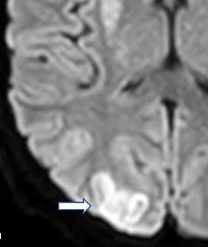In a case report Govindasamy et al. from the James Cook University Hospital, Middlesbrough published in Cureus to describe a rare complication—transient cortical blindness—following endovascular treatment of a basilar tip aneurysm. A 60-year-old woman developed transient cortical blindness post-endovascular embolization for a 1.2 cm incidental basilar tip aneurysm. Symptoms included bilateral vision loss and confusion, with full visual recovery within 48 hours. MRI showed no infarction, and Posterior Reversible Encephalopathy Syndrome (PRES) was ruled out due to the absence of other characteristic features. The authors suggest contrast-induced transient cortical blindness as the most likely etiology 1)
Critical Review
This is a single-case report documenting a rare but recognized complication of endovascular procedures involving posterior circulation—the transient cortical blindness, likely due to contrast-induced neurotoxicity. The case is clearly described and provides a succinct narrative of presentation, procedural details, and post-operative events. However, the scientific value remains modest due to several limitations:
– Lack of Diagnostic Rigor: Despite a reasonable clinical rationale for ruling out PRES, the report fails to offer advanced imaging modalities (e.g., perfusion studies or susceptibility-weighted imaging) that might have better characterized transient cortical dysfunction.
– No Quantitative Data: The report is narrative-only and lacks imaging comparisons or standardized assessments (e.g., visual field tests, OCT) to strengthen the diagnosis.
– Limited Broader Implication: The authors do not contextualize the incidence or predictive risk factors for this complication in a broader series or literature review, limiting the clinical utility.
– Redundant Terminology: Use of both “transient cortical blindness” and potential PRES is confusing without firm exclusion criteria. PRES was too lightly dismissed without further exploration.
Final Verdict
A mildly informative but ultimately anecdotal report of a known but rare complication. Useful as a reminder for clinicians, but insufficient for practice-changing insights.
Takeaway for Neurosurgeons:
Transient cortical blindness is a self-limiting but alarming complication following posterior circulation endovascular interventions. Rule out PRES, infarction, and embolic etiologies with appropriate imaging and monitor closely.
Bottom Line:
Educational case with low generalizability and modest diagnostic work-up.
Rating: 3 / 10
Date: May 18, 2025
